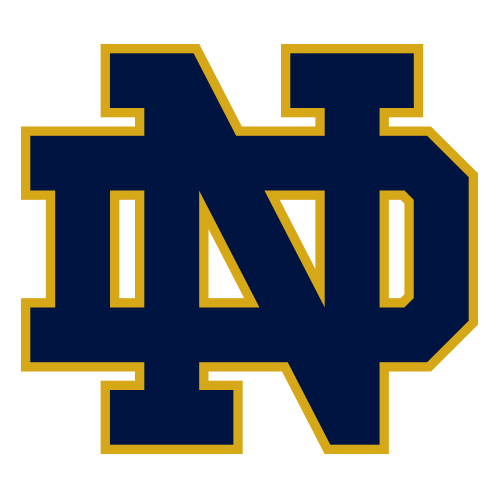Game Analysis
1-Star Best Bet – Notre Dame Team Total Under (29)
Lean – Indiana (+7 or more) 21 NOTRE DAME 24
Lean – Under (52)
A lot has been made of Indiana playing a weaker schedule than a typical Big 10 team and that they may not deserve to be in the playoffs. I can understand the point that the Hoosiers don’t have a win against a great team, but they only played one great team, and I think Ohio State is arguably the best team in the nation. So, most, if not all, of the teams in the playoffs playing Indiana’s schedule would have also lost at Ohio State and not all of them would have beaten the rest of the teams on Indiana’s schedule – and only a few probably would have beaten the other FBS teams that Indiana faced by an average score of 42.8 to 13.5.
Indiana is deserving simply because of how dominant they were in most of their games, which is more than can be said of Miami-Florida (lost to Georgia Tech and Syracuse) and Alabama, who lost to Vandy and Oklahoma. Alabama may have better wins than Indiana, but the Crimson Tide also have much worse losses and the Hoosiers mostly dominated teams at the level of Vandy and Oklahoma, as they beat better than average teams UCLA, Nebraska, Washington, and Michigan by an average margin of 24.3 points.
Despite all of the evidence that Indiana is a top-10 team, their offensive performance against Ohio State’s elite defense is a concern – particularly in this game against another elite defense. Indiana’s offense averaged 6.7 yards per play against FBS opponents that would combine to allow 5.5 yppl to an average attack but they managed just 3.1 yppl against the Buckeyes. Obviously, that doesn’t mean that they are not capable of moving the ball on a good defense, as drawing conclusions on a sample of one game is foolish. However, there is some merit to Indiana not being relatively as good when facing a better defensive team.
The regression analysis using the level of the opposing defense (adjusted by site) to predict Indiana’s yards per play in the 10 FBS games in which QB Kurtis Rourke played has a slope of 1.51, which means that they were 0.51 yards per play better, on a relatively basis, for every yard worse their opponent’s defense was (and visa versa). That is a better way to take into account their struggles against Ohio State’s defense and the Hoosiers also relatively struggled against Michigan’s solid defense – although they played very well against a couple of other better than average defensive teams. Using Notre Dame’s defensive level (adjusted for playing at home) would project Indiana to average 5.12 yppl in this game, which is 0.23 yppl less than my model would have predicted without using the regression equation. I will go with the 5.12 yppl prediction to give more weight to that Ohio State performance.
Notre Dame’s defense has been 1.2 yppl better than average this season but they struggled some against the two best offensive teams that they faced – giving up 434 yards at 5.8 yppl at home to Louisville in week 5 and yielding 557 yards at 7.2 yppl to USC a couple of weeks ago in a game in which they could have lost if not for a pair of 4th quarter endzone to endzone pick-sixes that turned likely USC points into 14 points for the Irish. Overall, however, Notre Dame’s defense was relatively as good against better than average offensive teams as against bad offensive teams.
Notre Dame’s pass defense hasn’t been as good in 6 games since Preseason All-American CB Benjamin Morrison was injured but part of that can be explained by the diminished pass run without DT Howard Cross III, who was second on the team in sacks despite missing the last 3 games. Morrison is still out but Cross is expected back for this game, and I don’t think any adjustment is needed for Morrison with Cross back.
Indiana can still compete in this game even if their offense struggles, as the Hoosiers’ defense is legit. Indiana’s defensive rating is actually better than Notre Dame’s defensive rating, as the Hoosiers have been 1.4 yppl better than average defensively, yielding just 15.7 points per game and 4.4 yppl to FBS teams that would combine to average 5.8 yppl against an average defense (which is only 0.1 yppl worse than the average offense that the Irish faced). That unit was just as good against better offensive teams, as they gave up just 5.7 yppl in that loss to the Buckeyes, which is 1.7 yppl better than an average defense would perform at Ohio State. The 38 points the Buckeyes scored in that game is a fluke given the 316 total yards they were held to by the Hoosiers.
Indiana is very good defending the pass (5.0 yppp allowed to quarterbacks that would average 6.5 yppp against an average defense) but their strength is defending the run, which they did better than any team other than Oklahoma this season. The Hoosiers gave up just 93 rush yards at 3.5 yards per rushing play to teams that would combine to average 5.0 yprp against an average team. Defending the run is a prerequisite for beating the Irish, who average more ground yards (228 per game) than air yards (189) this season. Riley Leonard is not a particularly good passer, as he settles for mostly short passes and was only 0.3 yards per pass play better than average, as he averaged 6.6 yppp against teams that would allow 6.3 yppp to an average quarterback.
Indiana isn’t the only offense that was relatively worse against better defensive teams, as the slope of the equation to predict Notre Dame’s offensive yards per play as a function of the opposing defensive rating (adjusted for site) is 1.65, which is even more extreme than the slope of the equation for the Indiana offense. Notre Dame faced 7 better than average defensive teams (Texas A&M, N Illinois, Miami-Ohio, Louisville, Georgia Tech, Florida State, and USC) and they were only 0.7 yppl better than average in those 7 games (6.1 yppl against teams that would allow 5.4 yppl), which is 0.4 yppl worse than their overall offensive rating of +1.1 yppl (6.7 yppl against teams that would allow 5.6 yppl), which was skewed upwards by the 10.1 yppl they gained against Army.
An argument can be made that two of those games against good defensive teams were the first two games of the season (Texas A&M and Northern Illinois) when new QB Leonard was getting his bearings. However, the Irish attack was relatively worse against better than average defensive teams even if you excluded those first 2 games (+0.9 yppl rating in the other 5 vs better than average defensive teams). A rating of +0.9 yppl is also what you get when you adjust for the Army game outlier by taking that game and their worst offensive game (vs N. Illinois) out – and that’s the level that I expect from Notre Dame’s offense for this game, which puts them at just 5.3 yppl against Indiana’s elite defense.
I don’t see either offense consistently moving the ball in this game and I see value on both Indiana and the Under. However, that value stems from Indiana’s underrated defense and I think the best way to play that edge is the bet the Notre Dame Team Total Under.
Notre Dame’s Team Total Under 28 points or more is a 1-Star Best Bet. The alternate play, if you don’t have Team Totals, is 1-Star on the game Under 52 points (at 51 or more).
- Team Stats
- Game Log
- Indiana
- Notre Dame
Rush
- Run Plays 34.5 26.3
- Run Yards 180.6 93.4
- YPRP 5.2 3.6
Pass
- Pass Comp 19.1 19.6
- Pass Att 27.8 31.0
- Comp % 68.6% 63.4%
- Pass Yards 259.4 185.8
- Sacks 1.6 2.4
- Sack Yards 12.0 17.0
- Sack % 5.3% 7.1%
- Pass Plays 29.4 33.4
- Net Pass Yards 247.4 168.8
- YPPP 8.4 5.1
Total
- Total Plays 63.8 59.6
- Total Yards 427.9 262.2
- YPPL 6.7 4.4
TO
- Int 0.5 1.1
- Int % 1.6% 3.5%
- Fumbles 0.3 0.7
- Turnovers 0.7 1.8
- Points 43.3 14.7


 Indiana
@
Indiana
@  Notre Dame
Notre Dame